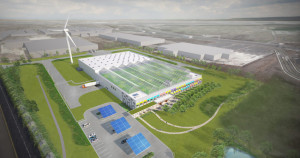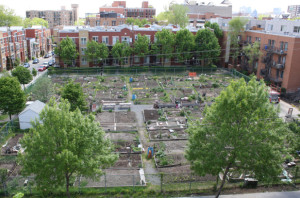Présentation de Mohamed Hage, président fondateur des Fermes Lufa lors de la conférence TEDx UdeM le 11 mars 2012.
From the Blog
Présentation de Mohamed Hage, président fondateur des Fermes Lufa lors de la conférence TEDx UdeM le 11 mars 2012.
by QUINN FORD, DNAinfo Chicago, March 4, 2014

The factory will include a wind turbine, solar panels and rooftop greenhouse
Renderings: William McDonough+Partners
Source: www.chicago.curbed.com
Construction on an environmentally-friendly manufacturing plant is officially underway on the city’s South Side.
Method, a company which boasts natural, nontoxic cleaning products, held an official groundbreaking ceremony for a $33 million plant being built in the Pullman neighborhood.
The plant, which was announced in July, is scheduled to open early next year and will be the company’s first manufacturing facility in the United States.
The company was lured to the South Side neighborhood in part by $9 million in city Tax Increment Financing funds as well as $1.1 million in state tax credits over 10 years.
The project will evenutally create nearly 100 jobs in the area once the factory is complete. Ald. Anthony Beale (9th) said the plant will provide a big economic boost to a neighborhood originally developed as a factory town.
“There hasn’t been a manufacturing company on the South Side in the city of Chicago for almost 30 years,” Beale said, prompting applause.
The plant’s plans call for a 230-foot wind turbine and solar panels that the company said will meet half the plant’s energy needs. Plans also call for greenhouses to cover the building’s roof, which company officials said will be rented out to vendors to grow fresh fruit and vegetables.
by AFP Relaxnews, The Star Online, January 13, 2014

Rooftop farming at Whole Foods Market in Brooklyn
Photo: Gotham-Greens / AFP
Source: www.thestar.com.my
Will supermarkets soon be growing their own produce on the roof? It might sound unusual, but it could be the future of the food commerce industry as the urban farming trend goes high-rise and spreads to metropolises all over the world.
One of the latest companies to test out the concept is global chain Whole Foods, which opened its first Brooklyn location Third and 3rd last month, featuring a 20,000-square foot (about 1,860sq m) greenhouse on the roof.
Designed, built and operated by urban agricultural specialist Gotham Greens, the project is thought to be the first commercial-sized greenhouse integrated into a supermarket.
The greenhouse will produce over 200 tonnes of fresh produce, including leafy greens and tomatoes, per year, and recirculating irrigation systems will capture water for re-use. It is the second New York construction by Gotham Greens, following a 15,000-square foot (about 1,400sq m) rooftop greenhouse built by the company in 2010.
par DAPHNÉE HACKER-B., Métro, 31 janvier 2014

Jardin communautaire Mile End
Photo: Josie Desmarais / Métro
Source: www.journalmetro.com
Des 97 jardins communautaires montréalais ensevelis en ce moment sous la neige, mais très populaires en été, 20 ont été identifiés comme ayant des terres dangereusement contaminées. Si les arrondissements ont tenté depuis de pallier le problème de différentes façons, la décontamination a été la solution la moins retenue.
Les potagers situés au sein d’une métropole comme Montréal sont directement soumis aux contaminations multiples issues des anciennes activités industrielles. C’est ce qui ressort d’une étude de toxicité des jardins communautaires menée par la Direction de la santé publique de Montréal (DSP), en 2009. Parmi les 20 jardins présentant une problématique de contamination, 9 cas touchent l’ensemble du jardin, tandis que dans les 11 autres, une section du terrain a été identifiée comme contaminée.
Grâce à une mise à jour effectuée par Métro, on constate que sept jardins ont été complètement ou partiellement fermés, tandis que seulement trois ont été décontaminés.
Press release via Reuters
43,000-square-foot greenhouse represents scalable approach for feeding cities
MONTREAL, QUEBEC–(Marketwired – Sept. 23, 2013) – Lufa Farms, which built the world’s first commercial rooftop greenhouse in early 2011, today unveiled its second greenhouse atop a newly constructed office building in the Montreal metropolitan area.
The greenhouse, located in Laval, will provide fresh produce to more than 6,000 people year round – about two times the yield of Lufa Farms’ first greenhouse in the Ahuntsic-Cartierville borough of Montreal. The company’s greenhouse system is scalable and can be replicated on new rooftops in any city.
“This greenhouse puts high-yield, rooftop agriculture within the reach of any new building development, in any city, on spaces public or private, anyplace in the world,” said Mohamed Hage, founder and president of Lufa Farms. “After almost five years of focus on the main issues of urban rooftop agriculture, we have solved how to cost-effectively grow food, distribute it, integrate it with local farming efforts, and do it all in an environmentally conscious, sustainable way. This doesn’t just change how food is grown, it changes how cities eat.”
Construction of the 43,000 square-foot greenhouse, visible from the 440 highway atop a new mixed-use commercial building, was the result of a collaboration between Lufa Farms, Le Groupe Montoni Division Construction, Inc. of Laval, and the Dutch company KUBO, a world-renowned greenhouse designer and manufacturer. The structure uses an innovative venting system to control pests and temperature and to optimize vital sunlight. The greenhouse also has a recirculating irrigation system for water and surface condensation.
par SABRI BENDIMERAD, 16 mars 2013
Visite des Fermes Lufa à Montréal, Mars 2013
Participants: Alena Prochazka et Sabri Bendimérad
Les Fermes Lufa proposent des paniers hebdomadaires d’assortiments de légumes saisonniers pour des particuliers ou des collectivités, produits dans des serres sur les toits d’un immeuble commercial d’une surface de 31000 pieds carrés. Elles se trouvent dans un quartier d’entrepôts et de grands bâtiments logistiques à Montréal. On y trouve aussi bien du commerce de gros de fruits et légumes que de la vente de meubles de salon kitch… Le quartier est une enclave bordée par un grand boulevard. Le stationnement des véhicules occupe l’espace vide laissé entre les bâtiments. Ceux-ci sont en béton préfabriqués ou en brique. Le réseau électrique est visible comme dans n’importe quelle zone industrielle d’Amérique du Nord On cherche l’entrée. Sur le côté, en face de la rue ou sur le boulevard ? L’occasion de voir les serres sous tous les angles. De l’extérieur, celles-ci coiffent le bâtiment de brique, rappelant les logements construits pour la cité manifeste de Mulhouse par Anne Lacaton et Jean-Philippe Vassal. Les plaques des sociétés s’affichent sans distinction typographique : au 2ème étage, se situent les Lufa Farms, inc. ! Un escalier mène à un étage où l’on trouve l’accueil, le conditionnement et l’expédition ainsi que des bureaux dans une grande salle où des cagettes vides font office de décor. La visite est impromptue mais nous sommes accueillis par une personne qui nous conduit aux serres.
Copyright © 2024 · Minimum Theme on Genesis Framework · WordPress · Log in